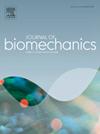Shear viscoelastic properties of human orbital fat
IF 2.4
3区 医学
Q3 BIOPHYSICS
引用次数: 0
Abstract
The shear viscoelastic behavior of eye’s supporting orbital fat is unstudied in humans, yet is important during and after rapid movement. This investigation quantified viscoelastic characteristics of human orbital fat in constitutive form suitable for numerical simulation.
Fresh human orbital fat was harvested postmortem from 6 male and 7 female donors of average age 78 ± 13 years. Fat samples were trimmed to disks of 20 ± 3.0 (standard deviation) mm average diameter and 2.1 ± 0.2 mm thickness. In 8 samples each, the following four testing protocols were performed: strain sweep from 0.0015 50 % at 1 Hz; viscometry at 0.1 s−1 shear rate; stress relaxation at physiological temperature; and frequency sweep from 0.159 to 15.9 Hz at 0.5 % strain to validate the Prony series parameters fitting stress relaxation behavior.
Orbital fat exhibited viscoelastic behavior under dynamic shear with a 0.5 % linear viscoelastic strain limit. Storage modulus averaged 737 ± 310 Pa, and loss modulus averaged 197 ± 76 Pa. Values were similar for strain and frequency sweep testing. At rupture, shear stress averaged 617 ± 366 Pa and rupture strain averaged 200 ± 70 %. The long-term relaxation modulus averaged 646 ± 264 Pa at 100 s. Frequency sweep testing validated the parameters of the Prony series fitted to the experimental stress relaxation data.
Human orbital fat is linearly viscoelastic within a range typical of biological materials, and exhibits similar viscoelastic behavior for strain and frequency sweep testing. Stress relaxation data for human orbital fat has been parameterized for constitutive models that can be implemented in finite element analysis.
人体眼眶脂肪的剪切粘弹特性
眼球支撑眶脂肪的剪切粘弹性行为在人体中尚未得到研究,但在快速运动时和运动后却非常重要。这项研究以适合数值模拟的构成形式量化了人类眼眶脂肪的粘弹性特征。从 6 名男性和 7 名女性捐献者(平均年龄 78 ± 13 岁)的尸体上采集了新鲜的人类眼眶脂肪。脂肪样本被修剪成平均直径为 20 ± 3.0 毫米(标准偏差)、厚度为 2.1 ± 0.2 毫米的圆盘。每个样本有 8 个,分别进行了以下四种测试程序:以 1 Hz 频率从 0.0015 到 50 % 的应变扫描;以 0.1 s-1 的剪切速率进行粘度测量;生理温度下的应力松弛;以及以 0.5 % 的应变从 0.159 到 15.9 Hz 的频率扫描,以验证拟合应力松弛行为的 Prony 系列参数。轨道脂肪在动态剪切下表现出粘弹性行为,线性粘弹性应变极限为 0.5%。存储模量 G' 平均为 737 ± 310 Pa,损失模量 G″ 平均为 197 ± 76 Pa。断裂时,剪应力平均为 617 ± 366 帕,断裂应变平均为 200 ± 70 %。频率扫描测试验证了根据应力松弛实验数据拟合的普罗尼序列参数。人体眼眶脂肪在生物材料的典型范围内呈线性粘弹性,在应变和频率扫描测试中表现出相似的粘弹性行为。人体眼眶脂肪的应力松弛数据已被参数化,可用于有限元分析的构成模型。
本文章由计算机程序翻译,如有差异,请以英文原文为准。
求助全文
约1分钟内获得全文
求助全文
来源期刊

Journal of biomechanics
生物-工程:生物医学
CiteScore
5.10
自引率
4.20%
发文量
345
审稿时长
1 months
期刊介绍:
The Journal of Biomechanics publishes reports of original and substantial findings using the principles of mechanics to explore biological problems. Analytical, as well as experimental papers may be submitted, and the journal accepts original articles, surveys and perspective articles (usually by Editorial invitation only), book reviews and letters to the Editor. The criteria for acceptance of manuscripts include excellence, novelty, significance, clarity, conciseness and interest to the readership.
Papers published in the journal may cover a wide range of topics in biomechanics, including, but not limited to:
-Fundamental Topics - Biomechanics of the musculoskeletal, cardiovascular, and respiratory systems, mechanics of hard and soft tissues, biofluid mechanics, mechanics of prostheses and implant-tissue interfaces, mechanics of cells.
-Cardiovascular and Respiratory Biomechanics - Mechanics of blood-flow, air-flow, mechanics of the soft tissues, flow-tissue or flow-prosthesis interactions.
-Cell Biomechanics - Biomechanic analyses of cells, membranes and sub-cellular structures; the relationship of the mechanical environment to cell and tissue response.
-Dental Biomechanics - Design and analysis of dental tissues and prostheses, mechanics of chewing.
-Functional Tissue Engineering - The role of biomechanical factors in engineered tissue replacements and regenerative medicine.
-Injury Biomechanics - Mechanics of impact and trauma, dynamics of man-machine interaction.
-Molecular Biomechanics - Mechanical analyses of biomolecules.
-Orthopedic Biomechanics - Mechanics of fracture and fracture fixation, mechanics of implants and implant fixation, mechanics of bones and joints, wear of natural and artificial joints.
-Rehabilitation Biomechanics - Analyses of gait, mechanics of prosthetics and orthotics.
-Sports Biomechanics - Mechanical analyses of sports performance.
 求助内容:
求助内容: 应助结果提醒方式:
应助结果提醒方式:


